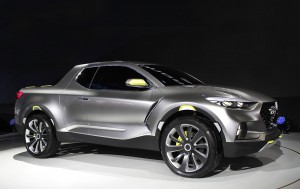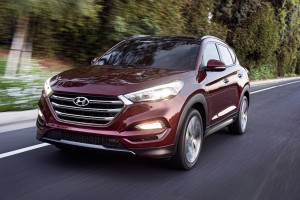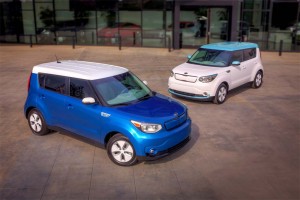In a market increasingly dominated by pickups and utility vehicles, Hyundai is “out of whack,” with a car-dominated model mix, but that’s about to change, says the company’s top U.S. executive.
Sometime before April, the Korean carmaker is formally planning to announce it will build the well-received Santa Cruz pickup that debuted in concept form at the 2015 Detroit Auto Show. But it will be just one in a flurry of new crossover-based models for both the mainstream Hyundai and new Genesis luxury brands, officials have confirmed.
“We’re out of whack, a fish swimming upstream,” in the current environment, said Hyundai Motor America CEO Dave Zuchowski, noting that while truck models currently account for 58% of the U.S. vehicle market, they make up barely 27% of Hyundai’s American volume.
And without getting more in line with market trends, Hyundai is beginning to see its steady growth begin to sputter, officials acknowledged during a media preview of the new Elantra sedan in San Diego.
Don’t expect to see the maker start rolling out traditional, truck-based products. There will be no full-size body-on-frame pickups to challenge the Ford F-150, and no Hyundai alternative to the truck-based Chevrolet Suburban.
But the car-based Hyundai Santa Cruz could find a strong audience among those who don’t need a traditional pickup, but something more flexible and fun to drive, the company is hoping. Receiving strong praise after its debut in Detroit, Hyundai has been rushing to develop a production model. It’s no longer a question of “if” the Santa Cruz will be built, Zuchowski told TheDetroitBureau.com during a later discussion, but when the official announcement will be made.
And he suggested a number of other announcements will follow. Currently, Hyundai offers the Tucson, Santa Fe and Santa Fe Sport, but within the next several years, the CEO said, the company could go “from three to what could be seven” utility vehicles. As with the Santa Cruz, they all would be based on car-like, unibody platforms.
The new models now in development include:
- A compact, or B-segment, crossover-utility vehicle for the Hyundai brand;
- A small luxury model for the new Genesis brand that would take aim at the BMW X3;
- A larger luxury ute for Genesis aimed at the BMW X5.
The Hyundai brand may also get an A-segment crossover along the lines of the Kia Soul, and likely using the same underlying platform.
(Click Here for more on Hyundai’s new Genesis luxury brand.)
Today, utility vehicles account for barely one in four of the products Hyundai sells in the U.S. By comparison, the overall market mix average about 58% truck last year, Zuchowski noted, rising to 60% in December. And he thinks the shift has not yet leveled off.
He’s not alone. Earlier this month, Ford President of the Americas Joe Hinrichs told TheDetroitBureau.com that utility vehicles alone could gain an additional 10% share of the U.S. market by the end of the decade. Ford is preparing for that by developing four more utes.
(SUV sales certain to keep growing. Click Here for more.)
There are a number of reasons why this shift is occurring, said Hyundai’s Zuchowski. “Part of the growth in trucks has been $2-a-gallon gasoline,” but motorists also like the flexibility utility vehicles offer, along with the higher, command seating position.
And so, while conventional trucks might suffer, if and when gas prices start rising again, the Hyundai chief is convinced this “generational shift” will mean that more fuel-efficient, car-based entries should continue to gain ground.
Hyundai isn’t likely to match the truck-dominant mix of domestic brands like Ford, General Motors or Chrysler, said Zuchowski. But, in the long-run, he believes its crossover utes – and the Santa Cruz – will eventually make up about 45% of its U.S. sales.
Hyundai isn’t waiting for the new products to reach production, however. It is trying to boost production of its existing truck models. That includes the recently announced addition of the Santa Fe Sport to its plant in Montgomery, Alabama. Currently, the Sport model’s production is capped at 75,000 annually. The move will yield about 50,000 more of the crossovers each year.
(Hyundai among the manufacturers adding new crash-avoidance technologies. Click Here for the story.)




Kind of like the Subura Baja which is rarely seen in my area. Will depend on load capacity, and price.
They can probably sell three per year. LOL